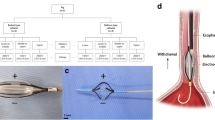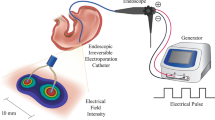Abstract
New mucosal ablative techniques that can be used in the esophagus have emerged over the past two decades. These techniques have been developed primarily to treat the precursors of esophageal adenocarcinoma: dysplasia in Barrett's esophagus and early esophageal cancer. Although high-grade dysplasia and early stage cancer can be treated with esophagectomy, the inherent morbidity and mortality of esophageal adenocarcinoma and the morbidities, difficulties, costs and limitations of the current technology mean that there has been a significant increase in interest and research regarding alternative treatments such as ablative techniques. At this stage it is not clear which of the numerous endoscopic ablative techniques available—photodynamic therapy, laser therapy, multipolar electrocoagulation, argon plasma coagulation, endoscopic mucosal resection, radiofrequency ablation or cryotherapy—will emerge as superior. In addition, it has yet to be determined whether the risks associated with ablation therapy are less than the risk of Barrett's esophagus progressing to cancer. Whether ablation therapy eliminates or significantly reduces the risk of cancer, eliminates the need for surveillance endoscopy, or is cost-effective, also remains to be seen. Comparative trials that are now underway should help to answer these questions.
This is a preview of subscription content, access via your institution
Access options
Subscribe to this journal
Receive 12 print issues and online access
$209.00 per year
only $17.42 per issue
Buy this article
- Purchase on Springer Link
- Instant access to full article PDF
Prices may be subject to local taxes which are calculated during checkout


Similar content being viewed by others
References
Brown LM and Devesa SS (2002) Esophageal and gastric cancer in the United States. Ann Epidemiol 12: 492–493
Devesa SS et al. (1998) Changing patterns in the incidence of esophageal and gastric carcinoma in the United States. Cancer 83: 2049–2053
Lagergren J et al. (1999) Symptomatic gastroesophageal reflux as a risk factor for esophageal adenocarcinoma. N Engl J Med 340: 825–831
Falk GW (2002) Barrett's esophagus. Gastroenterology 122: 1569–1591
Gross CP et al. (2002) The Adoption of Ablation Therapy for Barrett's Esophagus: A Cohort Study of Gastroenterologists. Am J Gastro 97: 279–286
Haag S et al. (1999) Regression of Barrett's esophagus: the role of acid suppression, surgery and ablative methods. Gatrointest Endosc 50: 229–240
Brown SB et al. (2004) The present and future role of photodynamic therapy in cancer treatment. Lancet Oncol 5: 497–508
Tang S et al. (2004) Photodynamic therapy in the esophagus. Photodiagnosis and Photodynamic Therapy 1: 65–74
US Food and Drug Administration (2003) FDA approves Photofrin for treatment of pre-cancerous lesions in Barrett's esophagus [http://www.fda.gov/bbs/topics/ANSWERS/2003/ANS01246.html] (accessed 6 June 2005)
Overholt BF et al. (1999) Photodynamic therapy for Barrett's esophagus: follow-up in 100 patients. Gastrointest Endosc 49: 1–7
Rohini V et al. (2004) Cost-effectiveness of photodynamic therapy for high-grade dysplasia in Barrett's esophagus. Gastrointest Endosc 60: 739–756
Ban S et al. (2004) Histoplatholoci Aspects of Photodynamic Therapy for Dysplasia and Early Adenocarcinoma Arising in Barrett's Esophagus. Am J Surg Pathol 28: 1466–1473
Van den Bogert J et al. (1999) Endoscopic ablation for Barrett's esophagus with high grade dysplasia: a review. Am J Gastroenterol 94: 1153–1160
Gossner L et al. (1999) KTP laser destruction of dysplasia and early cancer in columnar-lined Barrett's esophagus. Gastrointest Endosc 49: 8–12
Biddlestone LR et al. (1998) The histopathology of treated Barrett's esophagus. Squamous reepithelialization after acid suppression and laser and photodynamic therapy. Am J Surg Pathol 22: 239–245
Salo JA et al. (1998) Treatment of Barrett's esophagus by endoscopic laser ablation and antireflux surgery. Ann Surg 227: 621–623
Bonavina L et al. (1999) Endoscopic laser ablation of nondysplastic Barrett's epithelium: is it worthwhile? J Gastrointest Surg 3: 194–199
Barham CP et al. (1997) Photothermal laser ablation of Barrett's oesophagus: endoscopic and histologic evidence of squamous re-epithelialisation. Gut 41: 281–284
Luman W et al. (1996) Failure of Nd—YAG photocoagulation therapy as treatment for Barrett's esophagus: a pilot study. Eur J Gastroenterol Hepatol 8: 627–630
Weston AP and Sharma P (2002) Neodymium:yttrium-aluminum garnet contact laser ablation of Barrett's high grade dysplasia and early adenocarcinoma. Am J Gastroenterol 97: 2998–3006
Eisen GM (2003) Ablation therapy in Barrett's esophagus. Gastrointest Endosc 58: 760–769
Michopoulos S et al. (1999) Complete regression of Barrett's esophagus with heat probe thermocoagulation: mid-term results. Gastrointest Endsoc 50: 165–172
Sampliner RE et al. (1996) Reversal of Barrett's esophagus with acid suppression and multipolar electrocoagulation: preliminary results. Gastrointest Endosc 44: 532–535
Kovacs BJ et al. (1999) Successful reversal of Barrett's esophagus with multipolar electrocoagulation despite inadequate acid suppression. Gastrointest Endosc 49: 547–553
Montes CG et al. (1999) Antireflux surgery followed by bipolar electrocoagulation in the treatment of Barrett's esophagus. Gastrointest Endosc 50: 173–177
Sharma P et al. (1997) Normalization of esophageal pH with high-dose proton pump inhibitor theray does not result in regression of Barrett's esophagus. Am J Gastroenterol 92: 582–585
Ackroyed R (1999) Ablation treatment for Barrett's oesophagus: what depth of tissue destruction is needed? J Clin Pathol 52: 509–512
Sampliner RE (2004) Endoscopic ablative therapy for Barrett's esophagus: current status. Gastrointest Endosc 59: 66–69
Kahaleh M et al. (2002) Long-term follow-up and factors predictive of recurrence in Barrett's esophagus treated by argon plasma coagulation and acid suppression. Endoscopy 34: 950–955
Schulz H et al. (2000) Ablation of Barrett's epithelium by endoscopic argon plasma coagulation in combination with high-dose omeprazole. Gastrointest Endosc 51: 659–663
Madisch A et al. (2005) Long-term follow-up after complete ablation of Barrett's esophagus with argon plasma coagulation. World J Gastroenterol 11: 1182–1186
Byrne JP et al. (1998) Restoration of the normal squamous lining in Barrett's esophagus by argon beam plasma coagulation. Am J Gastroenterol 93: 1810–1815
Soetikno RM et al. (2003) Endoscopic mucosal resection. Gastrointest Endosc 57: 567–579
Ell C et al. (2000) Endoscopic mucosal resection of early cancer and high-grade dysplasia in Barrett's esophagus. Gastroenterology 118: 670–677
Seewald S et al. (2003) Circumferential EMR and complete removal of Barrett's epithelium: A new approach to management of Barrett's esophagus containing high-grade intraepithelial neoplasia and intramucosal carcinoma. Gastrointest Endosc 57: 854–859
Ganz RA et al. (2004) Complete ablation of esophageal epithelium with a balloon-based bipolar electrode: a phased evaluation in the porcine and in the human esophagus. Gastrointest Endosc 60: 1002–1010
Sharma VK et al. (2004) A Randomized Multi-Center Trial of Radiofrequency (RF) Ablation of Specialized Intestinal Metaplasia (SIM) of the Esophagus Using a Balloon-based Bipolar Electrode Array: Preliminary Results [abstract]. Gastroentest Endosc 59: a718
Grana L et al. (1981) Freezing of the esophagus: histologic changes and immunologic response. Int Surg 66: 295–301
Dvorakova K et al. (2005) Apoptosis Resistance in Barrett's Esophagus: Ex vivo Bioassy of Live Stressed Tissue. Am J Gastroenterol 100: 424–431
Johnston MH et al.: Cryoablation of Barrett's esophagus (BE): A pilot study. Gastrointestinal Endosc, in press
Peters FP et al. (2005) Endoscopic treatment of high-grade dysplasia and early stage cancer in Barrett's esophagus. Gastrointest Endosc 61: 506–514
Dulai GS et al. (2005) Randomized trial of argon plasma coagulation vs. multipolar electrocoagulation for ablation of Barrett's esophagus. Gastrointest Endosc 61: 232–240
Kelty CJ et al. (2004) Endoscopic Ablation of Barrett's Oesophagus: A Randomized-Controlled Trial of Photodynamic Therapy vs. Argon Plasma Coagulation. Aliment Pharmacol Ther 20: 1289–1296
Faigel DO (2002) Effect of multipolar electrocoagulation on EUS findings in Barrett's esophagus. Gastrointest Endosc 55: 23–26
Sampliner RE (1997) Ablative therapies for the columnar-lined esophagus. Gastroenterol Clin North Am 26: 685–694
Johnston MH (2003) Cryotherapy and other new techniques. Gastrointest Endoscopy Clin N Am 13: 491–504
Van Laethem JL et al. (2001) Argon plasma coagulation in the treatment of Barrett's high-grade dysplasia and in situ adenocarcinoma. Endoscopy 33: 257–261
Van Laethem JL et al. (2000) Intramucosal adenocarcinoma arising under squamous reepithelialization of Barrett's esophagus. Gut 46: 574–547
Author information
Authors and Affiliations
Corresponding author
Ethics declarations
Competing interests
Research at the author's institution was funded through a Cooperative Research and Development Agreement (CRADA) between CryMed Technologies and that National Naval Medical Center. The author has served as a medical consultant to CryoMed Technologies.
Glossary
- BLENDED ELECTROSURGICAL CURRENT
-
A combination of cutting and coagulating current; current delivered by electrocautery devices can be set at pure cut, pure coagulation or a combination of both
- MACROSCOPIC TYPE LESIONS
-
Endoscopic staging of lesions as type I (polypoid), IIA (flat elevated), IIB (flat), IIC (depressed), IIA+C (flat elevated and depressed), and III (ulcerated)
Rights and permissions
About this article
Cite this article
Johnston, M. Technology Insight: ablative techniques for Barrett's esophagus—current and emerging trends. Nat Rev Gastroenterol Hepatol 2, 323–330 (2005). https://doi.org/10.1038/ncpgasthep0214
Received:
Accepted:
Issue Date:
DOI: https://doi.org/10.1038/ncpgasthep0214
This article is cited by
-
The focus of Langenbeck’s Archives of Surgery in the 21st century
Langenbeck's Archives of Surgery (2010)
-
Mucosal ablation of Barrett esophagus
Nature Reviews Gastroenterology & Hepatology (2009)
-
Barrett’s oesophagus: an ideal model to study cancer genetics
Human Genetics (2009)
-
Vaccine Impedes the Development of Reflux-induced Esophageal Cancer in a Surgical Rat Model: Efficacy of the Vaccine in a Post-Barrett’s Esophagus Setting
Digestive Diseases and Sciences (2008)
-
Œsophage de Barrett: rôle du pathologiste dans le diagnostic, la surveillance et la prise en charge thérapeutique
Acta Endoscopica (2008)



